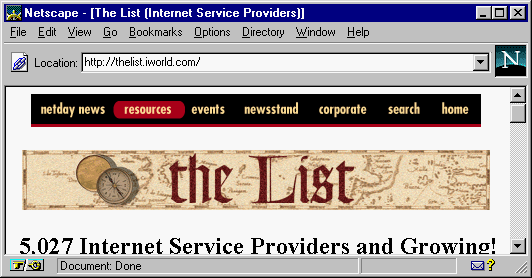 |
This is the On-line companion to my monthly column in
Enterprise Reengineering
The National Publication for BPR
|
||
This is the On-line companion to my monthly column in |
Finding the Ideal Internet Provider
(Originally published in the October 1996 issue - Recently updated to reflect
changes to the Internet)
Throughout the year, I have provided pointers to many valuable internet resources. Implicit in my advice was the assumption that you all had fast, reliable access to the Internet. This column is dedicated to those of you who are shopping for a new/better internet service provider (ISP).
Dial-up Connection
A dial-up connection is suitable for individuals users, or workstations that are not on a corporate network. With this style of connection, you use a modem and existing phone lines to reach an ISP. There are thousands of Internet Service Providers who provide access to individual users and companies. The most complete list of providers is located at The List. The List is useful in that you can search for an ISP based on country, state, or area code.

The List may indicate several dozen ISP's who serve your area code. The List may also provide summary information about the ISP and a link to that ISP's home page. There are several considerations for picking an ISP for dial-up services:
Dedicated Connection:
Organizations with a significant number of users on a LAN will be interested in a dedicated connection. A popular size connection is a "T1" which provides up to 1.5 Mb/sec of throughput. ISP's charge a flat monthly rate for a T-1 which includes their fee and the cost of a dedicated line from your location to their nearest POP. The ISP will arrange for the dedicated line usually through the local phone carrier.
When shopping for a dedicated connection, I would recommend that you only consider those ISP's who have significant backbone capacities and who are directly connected to the Internet's Network Access Points, or NAPs (MFS also operates some of the largest Interconnections points - they are called MAE's). Out of the many thousands of ISP's, there are only a handful which operate extensive high-speed backbone networks. Most other ISP's derive their connectivity from the larger ISP's. Russ Haynal's ISP Meta Site lists several of these major ISP's and includes linkages to the major US NAPs, complete with lists of who is connected at each NAP. Examining the list of ISP's connected at each NAP, will help indicate which ISP's are the major providers. You may also want to consult Jack Rickard's informative article about the Internet's architecture.
In comparing the top half-dozen ISP's, you will want to examine their backbone network. Buying a T1 from an ISP is worthless, if they don't have the capacity to handle the aggregate traffic of all their users. A good example of a backbone is UUNET's backbone map, where you can see redundant high speed connections into many major cities. I would not buy a dedicated internet connection from an ISP who won't show you their backbone diagram.
You may notice that many ISP's brag about their connectivity into the NAP's. In fact is seems that many "backbone providers" only have network connections to/from the NAPs (for example look at this backbone map from Genuity) what happens if you are located in Florida? How does your connection reach the ISP's main backbone? To better visualize this, look at this backbone map from ANS, they have a 45 MBs backbone, but many states and cities are served by only 1 or 2 T-1 connections. This capacity is then shared amongst all the company's customers in that state. If you look back at UUNET's US Map, you can see that they are better positioned to provide high speed access to a customer in Florida.
You must understand how your connection enters into an ISP's backbone, and how your traffic will ultimately reach a NAP or top ISP. If your existing corporate connection seems slow, ask your ISP about these backbone details.
There is also a higher level of Internet connectivity that has emerged during the past couple years. Being physically connected to the NAP's does not automatically mean you are connected to the rest of the Internet's networks. An ISP must enter into peering agreements or transit agreements with the other Major ISP's at the NAPs. Otherwise there is "no place" for the ISP's traffic to go - they will be unable to reach the rest of the world. In order for an ISP to be truly well connected, they should have agreements in place (either directly or indirectly) with one or more of the top handful of ISP backbone providers; UUNET, MCI, Sprint, ANS, BBN, and PSI. These larger providers may also establish private Interconnections between themselves, which bypass the public exchange points.
Some ISP's will also offer a variety of services which you may need.
As with most service industries, there can be a wide variety in the quality of service provided by these ISP's. Many ISP's are growing exponentially, and may not have the financial resources to "grow gracefully" Be sure to ask around. Many people love to tell you want they think of their ISP ;-)
Note: I recognize that even this column assumes that you have access to the Internet. If don't yet have access, your options include:
Russ Haynal
Please be sure to visit my Archive of BPR articles.
| Home Page | Services / Background |
| I can be reached at Russweb@navigators.com or 703-729-1757 Copyright © 1997 Information Navigators |
|